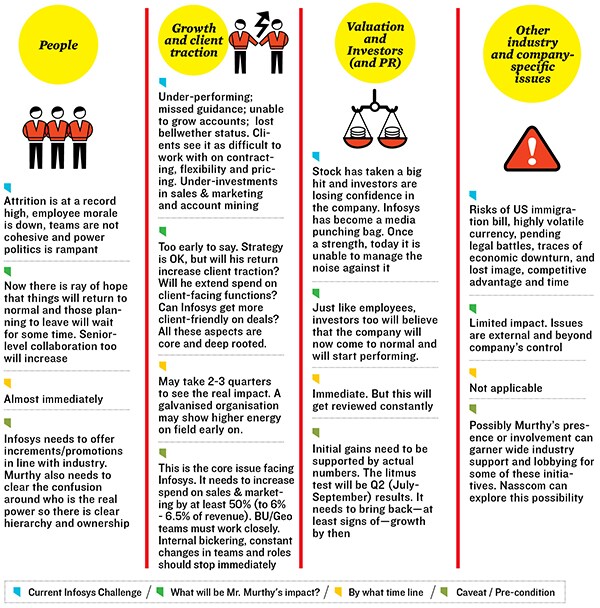Watching Infosys: What Narayana Murthy's Second Innings Entails
Five Infy watchers spell out the challenges that the company and NR Narayana Murthy will have to face up to


For someone who had a dream First Innings, NR Narayana Murthy may find that the playing pitch in the Second Innings may be quite different. Somewhere between the time he bid goodbye to Infosys and now, the leadership of the company he founded dropped the ball just when the game was getting more competitive.
In a difficult operating environment, Infy’s rivals proved to be more nimble and adaptive, forcing the company to lose traction both with customers and investors. Despite having a good strategy to move up the value chain, the leadership failed to execute Infosys 3.0 well. Worse, it also started losing its grip on bread-and-butter businesses like application development and maintenance while chasing margins—a point Murthy himself acknowledges.
Can Murthy rescue Infy from the morass it got itself into? Forbes India asked five close Infy watchers what the company’s challenges were and what Murthy needed to do to turn it around. Here’s what they said. Read on.
Real Transformation or Symbolism?
Will the return of Narayana Murthy solve the challenges Infosys is facing?
By Sudin Apte
CEO & Research Director, Offshore Insights Research and Solutions
The irony, however, is that the frontiers on which Murthy can get quick success will ultimately depend on success in client traction and growth. A quick analysis of the reasons why Infosys underperformed shows that it is the very same factors that the founders, including Murthy, implemented that are becoming inhibitors for growth in a changed environment. For example, less appetite for risk, pricing and contracting inflexibility, limited investments in client-facing roles—these are not things that Infosys adopted in recent times. So, the question is, can Murthy break the rules that he himself set up years ago? The success of the company, and Murthy’s second innings, depends on how quickly he makes Infosys adapt to the new rules of business.
He Should Tweak Infy 3.0, and the Leadership team
By Pankaj Ghemawat
Anselmo Rubiralta Professor of Global Strategy at IESE Business School
I nfosys had to do something to break the negative cycle they are in. While bringing Murthy back itself does not solve this problem, it shows that they recognise the challenge they have to address.
The perception was that Infosys was struggling with no clear plan of breaking out of the negative cycle and while there are real challenges, there are perceptual challenges as well. He can address those. There is a haemorrhage of talent that people are talking about. I think Infoscions will now be a bit more inclined to stay put and see what happens. Similarly, investors and clients will be more patient. Having said that, there are some real challenges associated with the failure to achieve growth, etc, and those aren’t directly addressed by this move. But Infosys gets more time to address those challenges.
There’s been some debate about whether the company’s problem is the strategy (Infosys 3.0) or the execution (and by extension the leadership). It’s probably a combination of the two. They probably attempted too big a strategic leap at precisely the time when, due to succession issues, their capacity to execute it was diminished. What Infosys 3.0 tries to accomplish, in terms of moving up the value chain, is directionally correct in terms of where the industry is trying to go. So, in some sense, I think that rather than abandoning Infy 3.0, what they need to do is improve execution in the core business and in so doing generate the confidence to make their longer term vision a reality.
[One should] start by using the surge of attention on the company that will accompany his return by focusing on all of the positives that still exist. Do this as part of sharing interim findings during strategy review. Try to build customer confidence (to get all-important sales) as well as internal confidence (to stem attrition).
Then, have a clear announcement of strategy and focus on execution. There must be more focus on core business even while continuing to build toward long-term vision, probably not that different from Infy 3.0.
There’s been some talk of M&A, which is a potentially interesting avenue to show how Infy has changed and to accelerate growth. At the same time as announcing results of a strategy review, it may make sense to announce changes to the management team—although I am not familiar enough with the individuals in question to be more specific. That might also help instil a sense of accountability and real change.
Maybe they should even try to bring in some new blood—top people from Accenture, Cognizant, etc. (In short, combine Murthy as guardian of the “spirit” of Infy with some new perspectives.)
The Old New Boss Must Rev up the Sales Engine
By TV Mohandas Pai
Chairman of Manipal Global Education and former member of the board of directors of Infosys
The board of Infosys has invited NR Narayana Murthy (NRN) to come back as executive chairman, this time to resurrect the company. The last two years have been torrid for Infy with growth rates falling and profits declining. It lost its bellwether status, saw a competitor overtake it in growth and suddenly people started talking about Infy in the past tense.
It was essentially a crisis of leadership, unable to motivate its staff and increase sales, and suffering from indecision. It appeared uncertain and confused, with the strategy being marred by poor execution.
NRN has the uncanny ability of getting to the heart of any issue quickly, inspiring people to great heights, is quick in decision-making and is very focussed on growth and profits. His return will address the challenges Infy faces. The challenges were not the market, as many competitors have done well, nor its strategy, as it was a natural corollary of past direction, nor its brand, which has withstood the battering, nor its people, as Infy still has possibly the best group of people in the industry. The problem was indecisive leadership.
NRN’s biggest challenge will be to get the sales team performing again. Many have left, upset by the lack of empowerment and the tendency to let the back office decide on pricing and contracts. Every sales person knows that when you are in front of a client you need to decide quickly and clinch the deal, and if you cannot do so, the client loses respect for you. NRN had always understood the key role of sales, of being client-centric and of motivating and incentivising the sales force.
If he is able to get the sales engine performing again, the rest of the challenges of a large bench, of declining profits and reduced compensation would soon get fixed. There is also a need to revamp top management, empower the leaders and refocus them on growth and client-centricity. He has the big task of creating the new team which can run the company for the next five-seven years and set in place a succession plan for the future.
Infy has more than 100 senior leaders who can be CEOs of small, medium and large companies what they need is empowerment and the space to perform, which he has always ensured. A true democrat, he listens to everybody and supports the right decision. But when he is around, there is no confusion on who is the boss, no confusion on who is the final decision-maker and that makes all the difference between growth and stagnation.
NRN Should Create a Burning Platform
By R “Ray” Wang
Principal analyst & CEO, Constellation Research Much excitement arises when a legendary founder/co-founder comes back to “save” a company. [But] the conditions have changed so much in the industry that one may wonder if one man can make a difference in making the harsh business model changes required to turn the tide.
Much excitement arises when a legendary founder/co-founder comes back to “save” a company. [But] the conditions have changed so much in the industry that one may wonder if one man can make a difference in making the harsh business model changes required to turn the tide.
The good news: NRN has come back to shake up the company. He’s one of a few individuals with the acumen and authority to accomplish this challenge. However, he must rethink the business model, as product companies have become services companies, services companies have become information-based companies and information companies are selling experiences.
The key thing is for NRN to create a burning platform. The Edge products are a good start. However, there’s a lot of culture to change. This includes incentives, inspiration, recruiting for the next shift.
The original formula for success no longer exists as today’s Indian IT services firms have maxed out their current business models. The shift in technology decision-making to the business side, along with buyers’ need for innovation and their move to purchasing business outcomes (rather than just technology), has altered the demand-side environment in the technology space.
In addition, with Cloud, Mobility, Social, Big Data, and Unified Communications and Video becoming pervasive, four business models have emerged to not only meet client needs, but also spur non-linear growth for IT services firms. By applying differentiated intellectual property (IP) creation, enabling Big Data business models, delivering innovation value chains and leading partner ecosystems, Indian IT services firms can create new high-volume, high-value opportunities and become truly global players.
The issue is, the sales process needs to target the line of business leaders. However, companies do not yet see Infy as a strategic partner. This will take time. Infy must show thought leadership. It could benefit by buying an analyst firm, or creating an institute. In any case, it will need to keep pushing high-profile innovation to get there. The internal culture must also shift from service-based to IP-based. This means how you build, sell, and service a product has to be in the culture.
What does this say for the Infy succession plan? One would imagine that those who succeeded in transforming Infy will be the ones who win.
Infy needs to reset its margin targets in short run
By Bhavin Shah & Ravi Menon
Shah is MD & CEO, Equirus Securities & Menon is an analyst
We see the move to bring back NRN as executive chairman as tacit acknowledgement of our view that Infosys is facing an internal crisis. Infosys has lagged its peers substantially over the last three years because of several key internal issues related to massive attrition of experienced technical lead employees, low focus and penetration into high-growth opportunities in health care and remote infra services, and limited success of two of the three pillars of the 3.0 strategy—consulting and platform solutions.
As such, some big bang change was required right at the board level. We do have concerns about the effectiveness of the new structure with three executive roles at the top—a CEO, an executive vice-chairman and an executive chairman. However, these three founders have worked together for a very long time and hence we need to be patient. Clearly, with this change, Infosys has rewritten some of its rules around retirement age and family employment. The later change may bring unintended consequences that will have to be dealt with.
The underlying problems of Infosys are a result of years of policy decisions that resulted in industry-leading margins in spite of flat bill rates versus rising input costs. In his first TV interview post the announcement, NRN has reasserted the goal of achieving stable to rising margins through cost optimisation if revenues are commoditised and do not provide the margin lever.
We beg to differ Infosys may need to reset its margin targets at least in the intermediate run to put the company back on the growth path and regain its position as a preferred employer. While Infosys does have huge pyramid levers available (some 52 percent of the staff has more than five years of experience, suggesting room at the bottom) to optimise costs, the company needs to address big discontent among employees about real take-home pay and career path. That may require giving up margins at least in the near term. Infosys needs to do a very honest internal as well as external assessment. Why did Infosys lose 72,000 people in the last four years? What policies are resulting in much lower attrition at TCS?
First and foremost, Infosys needs to re-establish itself as an employer that is able to retain the right kind of talent. Infosys has upside room from utilisation and an employee pyramid. The company needs to find ways to at least achieve industry growth rate so that these margin levers can help the company offset downward pressures from re-calibrating its pay structure. A sharper focus on traditional lines of revenues as well as remote infra services could help.
The current approach to platform solutions and consulting have produced only limited success not because these are bad ideas but because the culture and risk-taking abilities required to develop such areas may not be possible within the existing setup. Infosys must have some good engineering behind some of its platform solutions but the company may need to rethink marketing strategy for the same. If consulting could not work as a separate unit, what chance does it have of working as part of industry verticals?
For a traditional application development and maintenance business to build meaningful revenue streams in non-linear areas such as platform solutions or high-end service lines such as consulting requires a lot of patience as well as risk-taking. Strong growth from traditional businesses would have given Infosys management that breathing space. We find certain lack of risk-taking culture in Infosys’s approach to the platform solutions business we did not see sufficient non-linearity in Infosys’s product and platforms business. We see many of the platforms being more akin to “accelerators” that help win and execute the time and material revenue model rather than being standalone solutions as such.
Also, while Infosys did come up with some well-engineered products such as BrandEdge, it may not have created a sufficient incentive structure for its marketing force to cultivate relationships with a new set of end-users that is required to achieve closure. Regarding the consulting and systems integration focus, it is not entirely clear whether Infosys created sufficient organisation underneath partner-level consultants to effectively market and execute its services.
What about the succession plan? It is very natural to speculate that Rohan Murthy, or maybe even the children of other founders, could be groomed to eventually run Infosys. Beyond this mere speculation, there is not much else one can say for the time being.
First Published: Jun 24, 2013, 06:27
Subscribe Now
